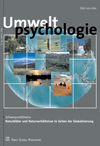Artikeldetails
 Tamara Münkemüller & Andreas Homburg (2005),
Tamara Münkemüller & Andreas Homburg (2005),Naturerfahrung: Dimensionen und Beeinflussung durch naturschutzfachliche Wertigkeit.
Umweltpsychologie 9(2), 50-67.
Dieser Artikel wurde in deutsch verfasst.
| Zusammenfassung: | Zum besseren Verständnis von möglichen positiven Auswirkungen von Natur und Landschaft auf die in ihr lebenden Menschen ist Naturerfahrung ein Schlüsselfaktor. Vor diesem Hintergrund untersucht die vorliegende Arbeit zum einen, ob sich thematisch unterschiedliche Dimensionen der Naturerfahrung validieren lassen, zum anderen wird die Bedeutung naturschutzfachlicher Wertigkeit von Landschaften für Naturerfahrungen analysiert. In einer quasiexperimentellen Feldstudie wurden BewohnerInnen von zwei Naturräumen mit jeweils hoher bzw. niedriger naturschutzfachlicher Wertigkeit befragt. Konfirmatorische Faktorenanalysen zeigen, dass Naturerfahrung über einen Metafaktor mit den fünf Dimensionen Ästhetik, Erkunden, Ökologie, Gesundheit und Nutzung beschrieben werden kann. Dieser Metafaktor korreliert positiv costumi cosplay mit der subjektiven Bewertung der Landschaft durch die BewohnerInnen. Die Dimension von Naturerfahrung, die direkt Stressverarbeitung fördert (Ästhetik), ist in der naturschutzfachlich wertvolleren Landschaft stärker ausgeprägt als in der weniger wertvollen Landschaft. Damit zeigt sich die potentielle Bedeutung von naturschutzfachlich wertvollen Landschaften für die Häufigkeit von Naturerfahrungen und damit für das Wohlbefinden der Bevölkerung. |
| Schlagworte: | Naturerfahrung Naturschutzfachliche Wertigkeit Naturwahrnehmung Präferenz von Landschaften |
| Abstract: | The analysis of environmental perception, such as enjoying scenic views, observing animals or hiking, is important not only to detect positive influences on human well-being but to improve our understanding of attitudes towards nature conservation. In this regard, our study highlights dimensions and determinants of environmental perception as well as the role of environmental perception for the acceptance of nature conservation. A special focus is on landscapes that are part of people’s everyday environment. We investigated the nature experience of residents of two landscapes (high-valued vs. low-valued with respect to criteria developed by conservationists) using a quasi-experimental design. We found that environmental perception can be explained by a metafactor with five dimensions (beauty, exploring, ecology, health and using). The stress-reducing dimension (beauty) is more pronounced in high-valued than in low-valued landscapes. Thus, our results indicate a high potential relevance of high-valued landscapes for the well-being of residents. Furthermore, we could show that a strongly pronounced environmental perception in the dimension ’ecology’ facilitates the acceptance of nature conservation. |
| Keywords: | Criteria Of Evaluation Environmental Perception Landscape Preferences Nature Conservation |
Zum Inhaltsverzeichnis

